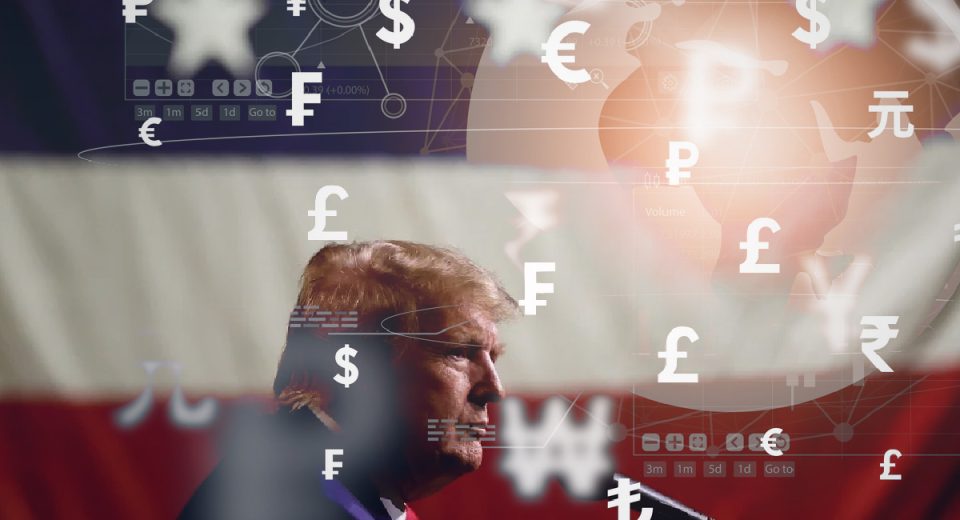Trump’s Tariffs: Headwind or Tailwind for the USD?

Joe Biden’s exit from the US Presidential race, Kamala Harris’ nomination and finally Donald Trump’s victory, 2024 was a year of unpredictability for the US political scene. This kept the US dollar volatile all year. The greenback rose to a 1-year high the day after Trump won the Presidential chair for the second time. The speculations of Trump’s policies supporting economic growth and delaying interest rate cuts fuelled the bullish sentiment. The DXY, the index that evaluates the USD against a bucket of major currencies, gained 6.5% in 2024. What’s in store for the world’s most traded currency as the new president takes over the United States?
Impact of Trump’s Agenda
According to the East Asia Forum, “Trump seems on course to dismantle four pillars of the Washington Consensus that guided US economic policy before his first election in 2017 — relatively free and non-discriminatory trade, open capital markets, modest budget deficits, and an independent central bank.” Here’s why.
Massive Tariffs
Trump promised an additional 10% tariff on China and 25% on Mexico and Canada during his campaign rallies. He also threatened 100% import tariffs on BRICS nations if they did not put an end to their attempts to move away from the “mighty US dollar.”
Disappointed, Canada and Mexico have clarified that if the incoming government goes through with the tariff hike, they will retaliate. The Chinese government may also announce retaliatory tariffs on US imports.
Against this backdrop, domestic firms dependent on imports will bear the brunt. They may pass on additional costs to consumers. These include automotive, retail, e-commerce, healthcare and energy sectors. A spike in inflation will discourage the Fed and push interest rate cuts further to the second half of the year, especially if domestic production fails to meet demand.
US and EU companies have started reviewing their supply chains and stocking as much raw material as possible before the tariffs come into effect. This is because retaliation against US exports deeply impacts domestic companies. Simultaneously, Chinese suppliers are looking for buyers elsewhere. This may translate into dampened economic growth in the US, and the US Dollar Index (DXY) may not experience much upside.
Elevated Interest Rates
In December 2024, the Fed lowered the key interest rate to the 4.25%-4.50% range. However, the US central bank emphasised that stubbornly high inflation may persist. Fed Chair Jerome Powell said that the “US economy has been remarkable.” In 2024, high inflation and elevated interest rates could not slow its growth. The 12-month CPI had climbed to 2.7% in November, from 2.6% in October in 2024.
Additionally, low unemployment rates indicate a strong job market. The Fed has, therefore, adopted a cautionary approach and may not lower interest rates till March 2025. Analysts widely speculate only two 0.25 bps cuts through 2025. Trump’s pro-business policies and extension of tax exemptions may boost domestic demand and business investment, fuelling economic growth. Indirectly, this will affect the Fed’s interest rate decision.
On the other side of the pond, inflation in the EU is cooling at a faster pace and the ECB is likely to continue to lower interest rates. The same holds true for the UK, with subdued economic growth and inflation at comfortable levels. The BoE is also expected to lower interest rates faster. The increased interest rate differential may fuel demand for the USD against the EUR and GBP. The heightened demand will lend support to the dollar and the DXY may climb further.
Widening Current Account Deficit
Since his last term, Trump has backed tariffs as an instrument to ensure national security and promote an America First agenda. He seeks to once again negotiate trade agreements with tariff threats. However, the lesson from his previous term is that this only feeds the country’s trade deficit.
The US current account deficit grew by 10.7% in 2024, indicating increased reliance on imported goods. Trump aims to reduce imbalances by using tariffs to negotiate trade terms or encourage domestic consumption. However, this has the potential to elevate the prices of goods in an import-dependent country. As inflationary pressures increase, economic growth may slow down, weighing on the US dollar.
Debt Risks
Trump failed to pay off the country’s debt through tariffs the last time he held office. Much like it did in the previous Trump presidency, the economic stimulus may accelerate national debt accumulation. This is because as tariffs come into play, consumer behaviour changes, imports decline, as does consumption. This shrinks the base from which the government aims to collect revenue to repay the debt. Extending tax rebates will further lower the government’s revenue. With all this, the debt will only continue to grow. While this may not be evident in the near term, it will affect the USD adversely over the next two to three years. So much so that the DXY may decline by 10% to 15% by 2028.
Therefore, forex trading decisions will need careful fundamental analysis. Staying abreast of the latest news on Trump’s policies and their impact on other nations will remain important.
To Sum Up
- Trump has promised huge tariffs for China, Mexico, Canada and the BRICS nations.
- High tariffs will adversely affect import-dependent businesses, stifling economic growth.
- They may cause inflation to reignite.
- Tariffs may also increase US debt build-up.
- In the short term, tariffs may lead to USD appreciation.
- In the longer term, the DXY may depreciate due to elevated debt.
Disclaimer:
All data, information and materials are published and provided “as is” solely for informational purposes only, and is not intended nor should be considered, in any way, as investment advice, recommendations, and/or suggestions for performing any actions with financial instruments. The information and opinions presented do not take into account any particular individual’s investment objectives, financial situation or needs, and hence does not constitute as an advice or a recommendation with respect to any investment product. All investors should seek advice from certified financial advisors based on their unique situation before making any investment decisions in accordance to their personal risk appetite. Blackwell Global endeavours to ensure that the information provided is complete and correct, but make no representation as to the actuality, accuracy or completeness of the information. Information, data and opinions may change without notice and Blackwell Global is not obliged to update on the changes. The opinions and views expressed are solely those of the authors and analysts and do not necessarily represent that of Blackwell Global or its management, shareholders, and affiliates. Any projections or views of the market provided may not prove to be accurate. Past performance is not necessarily an indicative of future performance. Blackwell Global assumes no liability for any loss arising directly or indirectly from use of or reliance on such information here in contained. Reproduction of this information, in whole or in part, is not permitted.




